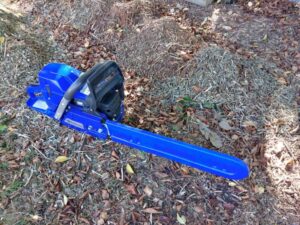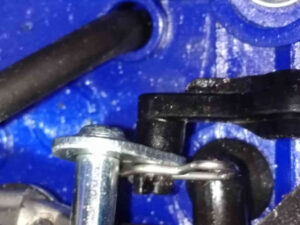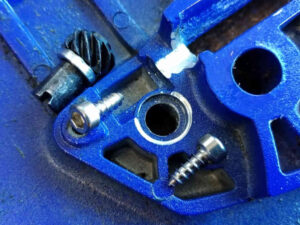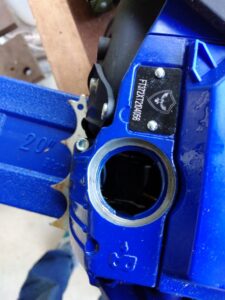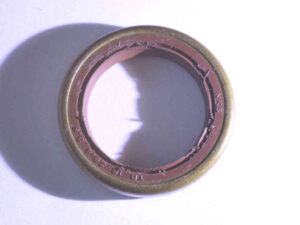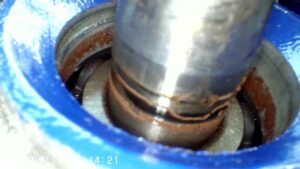I purchased a Holzforma G372XT chainsaw, it is a Chinese clone of the now discontinued Husqvarna 372XP X-TORQ. It is a relatively new technology carburetted engine without introducing electronic auto tune, a 20 year old design.
There are plenty of online discussions about the 372XP X-TORQ overheating, hot seizures, and pics of blued big ends, scored pistons and bores etc, so whilst the design achieves quite high power output for 71cc, one is warned to pay attention to mixture, fuel quality, and lubrication. This might be an engine that should not be used with other than full synthetic two stroke oil.
This article outlines out-of-the-box issues with the saw, basically all Chinese quality issues.
Problems
Recoil starter does not work properly
The cord would not reliably rewind into the starter. It turned out that this was not a matter of spring tension, but rather that the plastic spool jammed on its axle. A little reshaping, a thin smear of grease on the axle, resetting the tension and checking that the cord runs out before the spring solved the problem.
Would not start
Out of the box, it would not start.
Spark checked out fine (PET4000EC), lot of resistance to the pull cord, so it appeared to have adequate compression, so that left fuel as the issue.
I could not start it on 25:1, I eventually got it to start on 50:1 Amsoil Sabre but only after removing the spark plug several times and blowing the chamber out with compressed air, cleaning the plug in fuel and blowing it dry.
Now two strokes respond to a specific starting procedure, but this did not and it was flooding… probably due to the choke actuator coming off sometimes.
Proper functioning of the choke control is vital to starting of two strokes.
Choke actuator falls off the carburettor lever
The plastic choke actuator snap fits falls to the lever on the carburettor, it was not securely retained on the choke lever and fell off far too easily.
This leads for flooding when the choke is not turned off when the actuator is pushed in.
Above, the black plastic choke actuator was modified by drilling a 1.1mm hole and a 1mm 304 R-clip inserted to positively retain the actuator in the lever. The R-clip has to be of size and orientation that it does not interfere with other parts, eg the fuel tank hose grommet seen in this pic. The R clip can also be inserted from the front, but it needs the straight side down in both cases. A small cotter pin or bent wire are other options.
This might be regarded as a (Husqvarna) design issue, but in fairness, it is probably a matter of the quality of the plastic actuator, and the proper formation of the retaining ‘ears’, and it does appear it is the choke lever from an earlier model with different carburettor.
Chain tensioner binds
The chain tensioner binds at even modest chain tension. Side adjusting tensioners are convenient, but are commonly poor compared to the simpler front adjusting tensioners, but this one was really bad. On examination there were two causes:
- the aluminium casting did not have clearance for the end threads of the long threaded rod;
- the pinion would bind against the aluminium casting when tightening the tension screw; and
- tensioner cover screw sheared.
The first problem was fixed by relieving the casting with a carbide burr.
The second problem was solved by turning up a 12x8x2 aluminium bush to space the pinion from the casing, and discarding the existing washer and o-ring. A new Chinese no-name tensioner was fitted, although its pinion was a different length to the Holzforma one, it had the same issue with the o-ring and worked well with the new aluminium bush mentioned above.
In the process, one of the screw heads sheared off on the first attempt was made to remove the tensioner, so both screws were replaced (M3.5×10 ST hex head) seen in the pic below.
The pic shows the casing relieved to allow for the thread on the tensioner so that it does not bind, and the modified pinion assembly with aluminium spacer in lieu of the o-ring and thin washer. The pic shows where the original pinion scraped against the caser making the adjuster near impossible to adjust.
Chain catcher
The chain catcher fell off after less than an hour’s use. Fortunately the parts were found and reattached more securely. I should not be surprised if threadlock will be needed, being monitored right now.
Oil tank cap leaks
Above, the oil tank has been deformed and cracked by a severe blow near the edge of the cap, and the cap leaks. This did not happen in transit, it left the factory like this packed in a box. Repair of this is major, it means dismantling the saw completely and fitting a new half crankcase. This is Chinese Quality.
Crankcase seal air leak
It is impossible to set the L or H mixtures for stable RPM, the saw surges hinting a possible air leak which could lead to hot seizure.
A pressure and vacuum test after 3h of run time revealed inability to hold vacuum of more than 20kPa. The exhaust side of the piston was inspected through the exhaust port, and the exhaust side of the cylinder wall was inspected with a borescope through the spark plug hole, both were in as new condition so no significant damage from running lean due to the air leak.
Above is the PTO side crankshaft seal with just a few hours of use. The brown colour hints a Viton seal, but it is Chinese so you cannot trust conventional practice. The seal is quite chewed out. The oring between the shaft bushing and bearing was missing.
The flywheel side seal was poor, but not as poor as the PTO side seal.
Above is a pic of the crankshaft on the flywheel side after the seal was removed. Observed shredded brown material from the oil seal, and blackening of the crankshaft from carbonisation of seal and or lubricant (if there was any). The shaft was cleaned and polished with fine wet and dry to remove the carbonisation, silver coloured steel beneath it, no blueing. The PTO side shaft was quite similar.
New Husqvarna seals and oring were fitted (made in India), the seals lubricated with high temperature wheel bearing grease, and care taken to not invert the outer lip on the PTO side seal.
After 15min of run time, a pressure and vacuum test was conducted, and it held +50 and -50kPa fine.
During tuning adjustments it was found the throttle butterfly was not closing against the idle screw. Whilst the carburettor was out, the butterfly screw was loosened, recentred and tightened and that resolve the problem.
On a side note, the crankshaft bearings use metal carriers, not the nylon ones that appear on some modern chainsaws and which lead to catastrophic failures when they collapse.
Other modifications
Spark plug thread
It seems from online discussions that Holzforma spark plug threads can be a problem, so the spark plug hole was helicoiled as preventative maintenance.
Rings
It seems Holzforma piston rings can be a problem, so the first time the top end is disassembled, the rings will be replaced with Husqvarna rings. Holzforma top ends do not have a good reputation, it would probably be wiser just to fit a Meteor or other quality top end.
Lessons learned
Lots of small problems, though the air leak could quite quickly cause a hot seizure which would probably write the saw off.
I do have another Holzforma saw, a 395XP. This experience would prompt a pressure and vacuum test, but with suspicion that the seals may not be of good quality or properly install, the sensible things is to jump in and replace the seals, then pressure and vacuum test.
